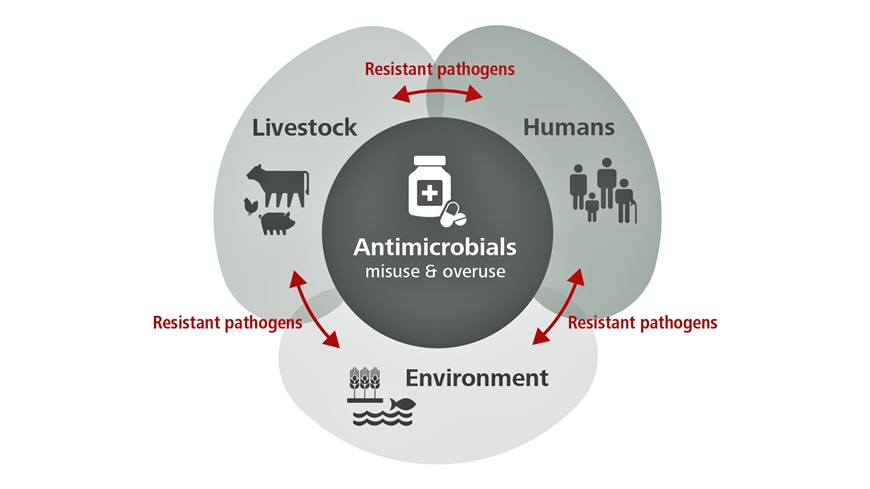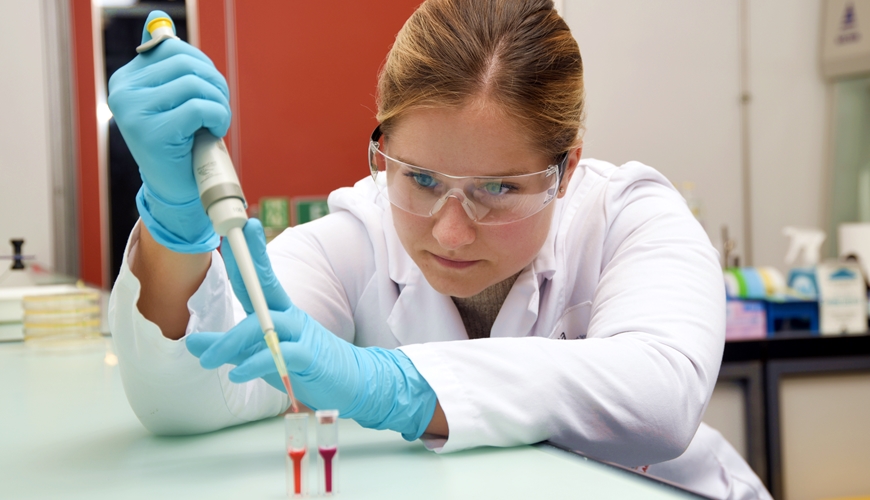Prevention of Antimicrobial Resistance (AMR)
Misuse and overuse of antibiotics and their improper disposal lead to antimicrobial resistance (AMR), the cause of the so called silent pandemic. Prevention strategies focus on the areas of stewardship, delivery techniques and innovative materials. Empa researchers work in several projects on improved antibiotic delivery techniques and smart antimicrobial materials to improve the prevention of antimicrobial resistance.

Antimicrobial resistance develops after misuse or overuse of antibiotics. Resistant pathogens circulate between humans, livestock and the environment. Prevention strategies have to tackle all of these areas. Illustration: Empa
What causes AMR?
- Antibiotic misuse and overuse: Misuse of antibiotics, including incomplete courses and suboptimal dosing, directly contributes to the development of resistance. Suboptimal dosing is particularly concerning when antibiotics are left in medical containments (e.g. lines) and are not administered to patients as intended.
- Antibiotic disposal: The improper disposal of antibiotics, such as pouring them down drains, contributes to environmental reservoirs of resistant microbes. Once in the environment, these antibiotics exert selective pressures that favors resistant bacteria, turning water systems and other environments into breeding grounds for so-called superbugs that are resistant to numerous, if not all available antibiotics.
How can we prevent AMR?
- Antibiotic stewardship: Ensuring careful and appropriate use of antibiotics in human medicine to reduce resistance by giving the right antibiotic for the right patient, at the right time with the right dose and the right route and duration causing the least harm to the patient. The combination of antibiotics with different modes of action enhances the success against the bacterial infection and thus reduces the risk of developing AMR.
- Antibiotic delivery: The proper selection and/or combination of antibiotics and their proper delivery can also contribute to the prevention of AMR. Moreover, the local delivery of antimicrobials provides a high concentration at the site of infection to ensure a complete killing of the germs. Optimizing local delivery systems without leaching to the environment can prevent AMR.
- Antimicrobial materials: The use of antimicrobial materials is another promising strategy to prevent AMR. These materials are designed to kill microorganisms, locally and fast, thereby reducing the need for traditional antibiotics and minimizing the risk of AMR development. Their advantage lies in their ability to provide continuous protection against a broad spectrum of microorganisms without contributing to resistance. For instance, materials like silver nanoparticles, copper alloys, and certain polymers have been shown to disrupt microbial cell membranes, interfere with essential metabolic processes, or generate reactive oxygen species that kill pathogens. Since these mechanisms are different from those of traditional antibiotics, they reduce the selective pressure that typically drives the development of AMR.

Empa researchers are currently working on several projects to improve AMR prevention. Image: Empa
Selected Empa projects on how to prevent AMR
| Project | Funding Partner | Lead Researcher |
| Transnational Research Projects on the Transmission Dynamics of AMR | SNF | Q. Ren |
| STOP – Surface Transfer of Pathogens | EU Horizon | Q. Ren |
| ProWoundCare – Probiotics for the Treatment of Skin Wound Infections | SNF | Q. Ren |
| Antibacterial Surfaces for Medical Urethral Devices | Innosuisse | K. Maniura/Q. Ren |
| ORALCOAT – Multifunctional Coatings for Oral Health Applications | Innosuisse | J.J. Schwiedrzik |
| Delicat – Delivery of Reactive Oxygen Species through a Catalytic Transport Layer | SNF | D. Hegemann |
| Safe Curtain: Antiviral and Antimicrobial Curtains for Hospital Use | Industry | P. Wick/G. Reina |
| Lignocellulosic Composite Hydrogels for Advanced Wound Dressing Applications | BAFU, Aktionsplan Holz | G. Nyström |
Information
Living materials, bioresponsive materials
Dr. Qun Ren
Biointerfaces
Phone +41 58 765 7688
Photoactive metal-based materials
Dr. Dirk Hegemann
Advanced Fibers
Phone +41 58 765 7268
Photoactive non-metal-based materials
Dr. Giacomo Reina
Particles-Biology Interactions
Phone +41 58 765 7344
-
Share
